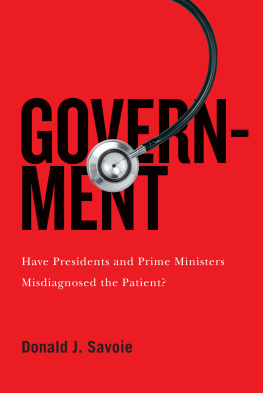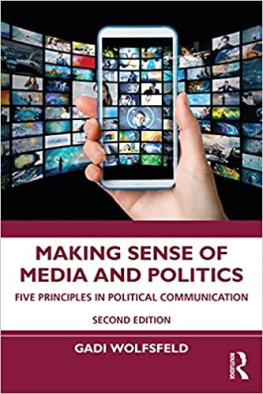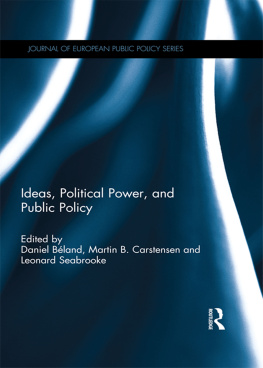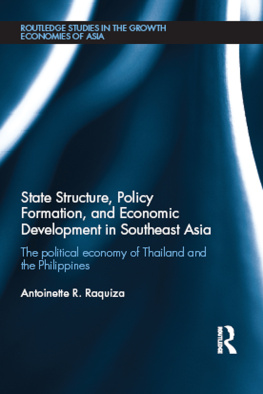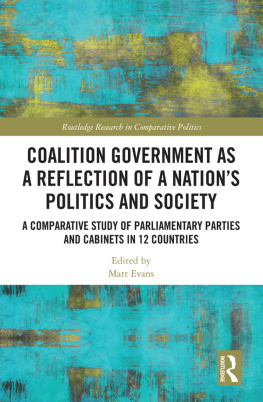POWER WHERE IS IT?
DONALD J. SAVOIE
POWER WHERE IS IT?

McGill-Queens University Press 2010
ISBN 978-0-7735-3726-2 (cloth)
ISBN 978-0-7735-3758-3 (pbk)
Legal deposit third quarter 2010
Bibliothque nationale du Qubec
Printed in Canada on acid-free paper that is 100% ancient forest free (100% post-consumer recycled), processed chlorine free
This book has been published with the help of a grant from the Universit de Moncton.
McGill-Queens University Press acknowledges the support of the Canada Council for the Arts for our publishing program. We also acknowledge the financial support of the Government of Canada through the Book Publishing Industry Development Program (BPIDP) for our publishing activities.
Library and Archives Canada Cataloguing in Publication
Savoie, Donald J., 1947
Power: where is it? / Donald J. Savoie.
Includes bibliographical references and index.
ISBN 978-0-7735-3726-2 (bnd)
ISBN 978-0-7735-3758-3 (pbk)
1. Power (Social sciences) Canada. 2. Canada Politics and government 21st century. I. Title.
HN49.P6P698 2010 303.330971 c2010-900646-1
Set in 10/13 Sabon with Frutiger
Book design & typesetting by Garet Markvoort
To all my students, past and present
CONTENTS
PREFACE
This book was born of a strong desire to understand why our political and administrative institutions are in a state of disrepair. It seems clear to me that they, along with the values governing political and economic life in Canada and, indeed, in much of the Anglo-American world have lost their vitality. I decided to seek answers by looking at those who hold or aspire to power and influence, whether political, bureaucratic, or economic. As a result, this study examines institutions, organizations, globalization, relations between the public and private sectors, the media, the public service, and a multitude of other policy actors. We need to understand their various roles if we are to see where power is located today.
The result is a book that is longer than I initially envisaged. Readers may become impatient with the material, but I hope that they will persevere. The state of representative democracy matters to all of us, and citizens need to be aware that it is in danger of being seriously eroded. Those with power see no problem: they are well served by the way things are.
My hope is that this book will shed some light on how the current situation came about and why. More particularly, I hope that it will prompt citizens to take a strong and informed interest in the state of their political and administrative institutions and organizations.
All authors are greatly in debt to colleagues, friends, and those who have travelled the territory before them. I acknowledge many such intellectual debts in the endnotes. Others, however, are not so formally acknowledged.
I have always benefited greatly from conversations with current and former senior government officials, at both the elected and appointed levels. This work is not different from my earlier books in that it would not have been possible without their assistance and insights. I also want to thank the two referees who reviewed the study for McGill-Queens University Press, when it was in manuscript form, for their observations and suggestions.
I owe a special thank-you to my wife Linda for putting up with my insatiable appetite for work, to my longtime assistant Ginette Benoit for her continued support and good cheer in the face of my constant demands, to Joan Harcourt for her sharp mind and her ability to make my sentences read better, and to Carlotta Lemieux for her fine work in editing the manuscript. But all the defects of this book are mine.
Donald J. Savoie
Universit de Moncton
POWER WHERE IS IT?
INTRODUCTION
Bertrand Russell once argued that power was the fundamental concept in social science in the same sense that energy is the fundamental concept in physics. He added that much like energy, power takes various forms, including wealth, the military, civil authority, and influence on opinion. But unlike energy, power can be created and destroyed. Like energy, however, it can move from place to place and take different forms. Indeed, political history is all about power who held it and how it was employed. Cato, the Roman politician, referred to power having different forms when he observed, When Cicero speaks, Romans marvel; when Caesar speaks, Romans march. Power in Catos time was fairly straightforward, and one did not need to look very far to see where it was located. A handful of individuals, institutions, and organizations held power in politics, commerce, and the military.
Today, things are vastly different. How organizations go about acquiring power differs from how individuals go about it, and in this book we examine power and its corollary responsibility from different perspectives in an attempt to locate where it now resides. Thus, politics and politicians, bureaucrats, public administration, globalization, the business community, organizational models, centralization, decentralization, the role of the media, and the impact of new means of communications will all be invoked. When I told a colleague of my plans for this book, he responded, You have my best wishes, but it is very unlikely that you will be able to pull it off.
Even a lifetime is not long enough to read all that has been written about it. The topic is of strong interest to philosophers, historians, political scientists, sociologists, economists, and those pursuing many other disciplines. But the risk is worthwhile if we are to make progress in mapping out where power and responsibility now reside. I will consider it a success if I can interest more students in the social sciences and humanities to tackle the question. The purpose of this book, then, is to open the way to further empirical and theoretical work on what I now consider to be the single most important question confronting representative democracy.
Things have changed considerably since 1938 when Russells book was first published. Power has become more fluid and considerably more difficult to locate. Its location notably though not exclusively in political power is now anything but clear. Elections do not always decide the question; the shaping of public policies and the delivery of public services are no longer just the product of democratically legitimized action by governments.
Constitutions no longer decide where political power resides to the extent that they once did. Given the demands and complexities of modern government, it is no longer possible, for example, for either of the senior orders of government in a federation to operate in a hermetically sealed jurisdiction. Accordingly, for the last thirty years at least, governments have devised numerous administrative instruments and processes to sidestep constitutional provisions.rapidly changing socio-economic circumstances and fast-emerging political developments has pushed them to search for flexibility in planning new initiatives and delivering public services. Most statutes are now broadly worded in order to provide greater flexibility for decision makers. To be sure, flexibility has its advantages, but it also makes it more difficult to locate precisely where political power and administrative authority lie.
Whether in North America or Europe, power and responsibility flow effortlessly between governments, between departments within governments, and, to a certain extent, between the public and private sectors. The European Community, the North American Free Trade Agreement (NAFTA), and collaborative federalism have mingled responsibilities to the point where it has become very difficult even for politicians to determine who is responsible for what in government. One can only imagine what it must be like for the voters. In addition, there is a wealth of analyses suggesting that political power has become highly dispersed and that non-state or non-government actors are increasingly competing with state actors as sources of power.
Next page

